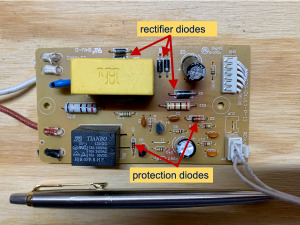Chapter 4. Diodes
This is first of three chapters dealing with semiconductor devices. We cover semiconductor diodes in this chapter, followed by transistors and operational amplifiers in the next two chapters. Diodes are used in power supply circuits as rectifiers that convert AC to DC voltages. They are also used to protect sensitive devices in circuits, such as transistors, from voltage “spikes” that can occur in certain situations. The following photo shows the power supply circuit removed from a coffee maker that uses seven diodes for different purposes that will be discussed in this chapter.

Light emitting diodes (LEDs) are now commonly used for lighting worldwide, having replaced less efficient incandescent lighting. Low power LEDs are often used in circuits as indicator lamps, glowing to provide proof that a device has been turned on, for example. The following picture shows blue, green, and red LEDs along with a combined red-green-blue (RGB) LED. The electronic materials that generate light are encased within the colored plastic dome, which serves to focus and diffuse, or soften the emitted light. The plastic dome color often, but not always, conveys the color of the emitted light from an LED. The RGB LED is actually three LEDs encased in a single plastic dome.

Light strips comprised of strings of RGB LEDS are often used to create decorative lighting. Different colors can be created by illuminating red, green, and blue diodes at different intensities. The magenta color shown in Figure 4.3, for example, is created by illuminating red and blue with equal intensity. This is discussed further later in this chapter.


